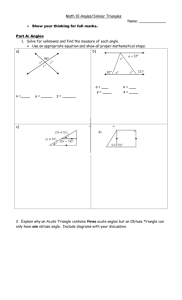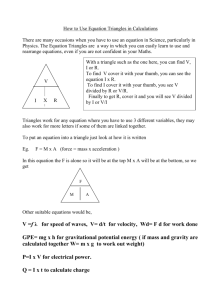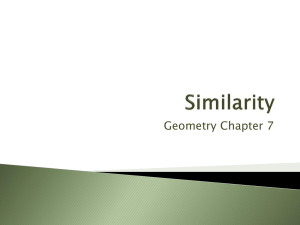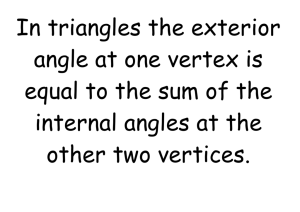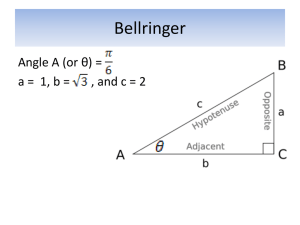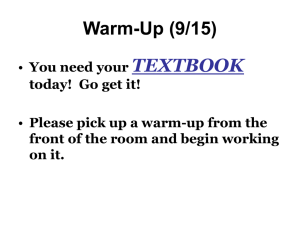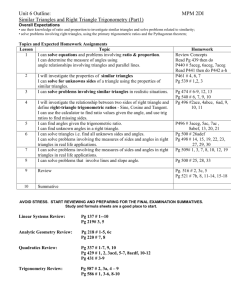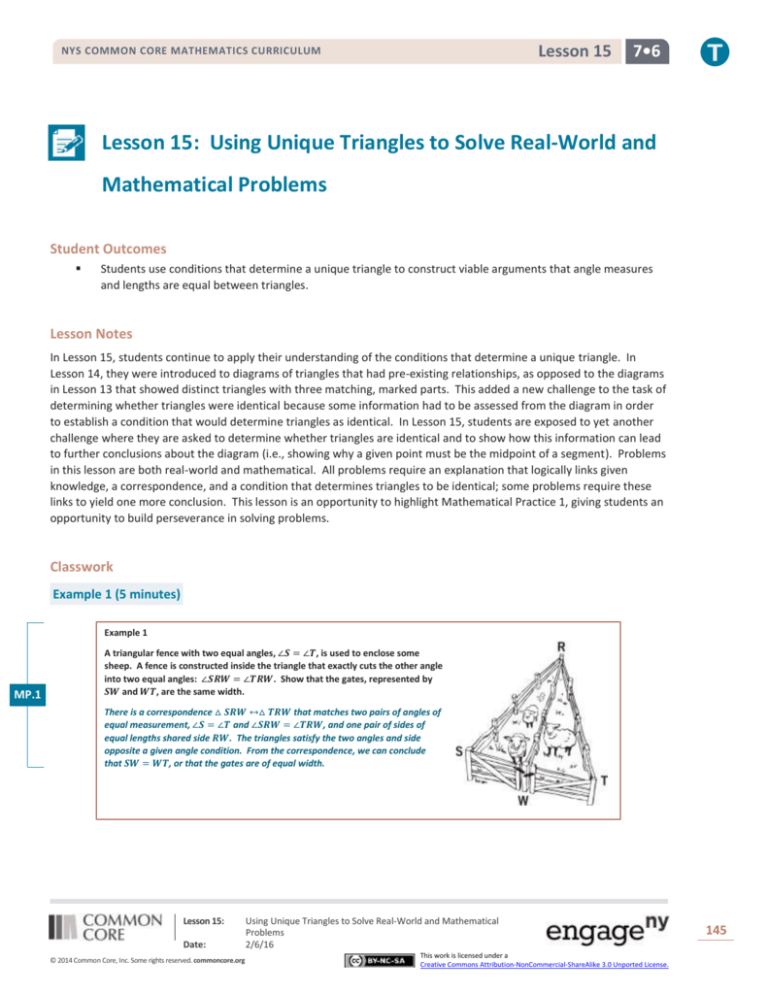
Lesson 15
NYS COMMON CORE MATHEMATICS CURRICULUM
7•6
Lesson 15: Using Unique Triangles to Solve Real-World and
Mathematical Problems
Student Outcomes
Students use conditions that determine a unique triangle to construct viable arguments that angle measures
and lengths are equal between triangles.
Lesson Notes
In Lesson 15, students continue to apply their understanding of the conditions that determine a unique triangle. In
Lesson 14, they were introduced to diagrams of triangles that had pre-existing relationships, as opposed to the diagrams
in Lesson 13 that showed distinct triangles with three matching, marked parts. This added a new challenge to the task of
determining whether triangles were identical because some information had to be assessed from the diagram in order
to establish a condition that would determine triangles as identical. In Lesson 15, students are exposed to yet another
challenge where they are asked to determine whether triangles are identical and to show how this information can lead
to further conclusions about the diagram (i.e., showing why a given point must be the midpoint of a segment). Problems
in this lesson are both real-world and mathematical. All problems require an explanation that logically links given
knowledge, a correspondence, and a condition that determines triangles to be identical; some problems require these
links to yield one more conclusion. This lesson is an opportunity to highlight Mathematical Practice 1, giving students an
opportunity to build perseverance in solving problems.
Classwork
Example 1 (5 minutes)
Example 1
MP.1
A triangular fence with two equal angles, ∠𝑺 = ∠𝑻, is used to enclose some
sheep. A fence is constructed inside the triangle that exactly cuts the other angle
into two equal angles: ∠𝑺𝑹𝑾 = ∠𝑻𝑹𝑾. Show that the gates, represented by
𝑺𝑾 and 𝑾𝑻, are the same width.
There is a correspondence △ 𝑺𝑹𝑾 ↔△ 𝑻𝑹𝑾 that matches two pairs of angles of
equal measurement, ∠𝑺 = ∠𝑻 and ∠𝑺𝑹𝑾 = ∠𝑻𝑹𝑾, and one pair of sides of
equal lengths shared side 𝑹𝑾. The triangles satisfy the two angles and side
opposite a given angle condition. From the correspondence, we can conclude
that 𝑺𝑾 = 𝑾𝑻, or that the gates are of equal width.
Lesson 15:
Date:
© 2014 Common Core, Inc. Some rights reserved. commoncore.org
Using Unique Triangles to Solve Real-World and Mathematical
Problems
2/6/16
This work is licensed under a
Creative Commons Attribution-NonCommercial-ShareAlike 3.0 Unported License.
145
Lesson 15
NYS COMMON CORE MATHEMATICS CURRICULUM
7•6
Example 2 (5 minutes)
Scaffolding:
As students work through Example 2, remind them that this question is addressed in an
easier format in Grade 4, when students folded the triangle so that 𝐴𝐶 folded onto 𝐵𝐶.
Example 2
In △ 𝑨𝑩𝑪, 𝑨𝑪 = 𝑩𝑪. John says that the triangle correspondence △ 𝑨𝑩𝑪 ↔△ 𝑩𝑨𝑪 matches two
sides and the included angle and shows that ∠𝑨 = ∠𝑩. Is John correct?
C
C
A
B
A
If needed, provide a hint:
Draw the segments 𝐴𝐶
and 𝐵𝐶.
Also, provide students
with compasses so that
they can mimic the
construction marks in the
diagram.
B
L esson Four t een, U sing U nique Tr iangles t o Solve R eal-W or ld and M at hem at ical
We are told that 𝑨𝑪 = 𝑩𝑪. The correspondence △ 𝑨𝑩𝑪 ↔△ 𝑩𝑨𝑪 tells us that 𝑩𝑪 ↔ 𝑨𝑪, 𝑪𝑨 ↔ 𝑪𝑩, and ∠𝑪 ↔ ∠𝑪, which
Pr oblems
means △ 𝑨𝑩𝑪 is identical to △ 𝑩𝑨𝑪 by the two sides and included angle condition. From the correspondence, we can
St udent Out
comes:
St udent
s use condit
ions t hat det ermine a unique t riangle t o const ruct viable
conclude
that ∠𝑨
= ∠𝑩; therefore,
John is correct.
argument
s
t
hat
angle
measures
of
lengt
hs
equal.
heyC,crit
ique
t\ he
of otInhers.
t riangle correspondence4.between
(Using aa ttriangle
riangle and
correspondence
itare
self.)
In 4 T
between
AB
\ aA
t=riangle
B .reasoning
and
Jill it self.)
4 AB C, \ A = \ B . Jill
t he t riangle correspondencesays
4 AB
t hat
C$
t he4t riangle
B AC mat
correspondence
ches two angles
4 AB
andCt he
$ included
4 B AC mat ches two angles and t he included
Exercises 1–4 (20 minutes)
January
plain why AC = B C. Is Jill
side
right
t o ?explain why AC = B C. Is Jill right ?
1. Mary put s t he cent er of her compass at t he vert ex O of t he angle and locat es point s A and
B onExercises
t he sides
1–4 of t he angle. She t hen cent ers her compass at each of A and B t o locat e point
#»
C. She
t
hen
const
ruct softher
hecompass
ray OC.
why
\ B
= points
\ AOC.
: sides
Draw
t he line
1. Mary puts
the center
at the Explain
vertex 𝑶 of the
angle
andOC
locates
𝑨 and 𝑩Hint
on the
of the
⃑⃑⃑⃑⃑⃑ .
segment sangle.
AC Next,
andshe
BC
centers her compass at each of 𝑨 and 𝑩 to locate point
C
C 𝑪. Finally, she constructs the ray 𝑶𝑪
Explain why ∠𝑩𝑶𝑪 = ∠𝑨𝑶𝑪.
B
B
O
A
A
B
C
O
B
A
O
A
C
B
A
Since Mary uses one compass adjustment to determine points 𝑨 and 𝑩, 𝑶𝑨 = 𝑶𝑩. Mary also uses the same
compass adjustment from 𝑩 and 𝑨 to find point 𝑪; this means 𝑩𝑪 = 𝑨𝑪. Side 𝑶𝑪 is common to both the triangles △
𝑶𝑩𝑪 and △ 𝑶𝑨𝑪. Therefore, there is a correspondence △ 𝑶𝑩𝑪 ↔△ 𝑶𝑨𝑪 that matches three pairs of equal sides,
A t riangular
wit
two equal
angles,
\ S = \ From
T , is
t o enclose
some that
sheep.
and thefence
triangles
arehidentical
by the three
sides condition.
theused
correspondence,
we conclude
∠𝑩𝑶𝑪A= fence
∠𝑨𝑶𝑪.
is
a
model
5.
of
Quadrilat
a
kit
e.
T
eral
he
diagonals
ACB
D
is
AB
a
model
and
CD
of
a
represent
kit
e.
T
he
t
he
diagonals
st
icks
AB
and
CD represent
is const ruct ed inside t he t riangle t hat exact ly cut s t he ot her angle int o two equal angles;
i.e.,
2.
eral ACB D
keep t he kit e\ rigid.
hat .help
keep
rigid.
SRW = \ TtRW
Show
t hatt he
Wkit
iset he
midpoint of t he part of t he fence from S t o T .
t he st icks
says t hat \ ACD = \ B CD(a)
. Can
Johnyou
says
uset hat
ident
\ ical
ACDt riangles
=R \ B CD
t o .show
Can tyou
hat use
Johnident
is ical t riangles t o show t hat John is
ect ?
correct ?
ays t hat t he two st icks are perpendicular
(b) Jill says t hat
t o each
t he two
ot her.
st icks
Useare
t heperpendicular
fact t hat \ ACD
t o each
= ot her. Use t he fact t hat \ ACD =
CD and ident ical t riangles t o show
\ B \CD
AEand
C =ident
90◦ .ical t riangles t o show \ AE C = 90◦ .
says t hat Jill’s t riangle correspondence
(c) John sayst hat
t hatshows
Jill’s t riangle
he st icks
correspondence
are perpendicular
t hat t shows
o
t he st icks are perpendicular t o
ot her also shows t hat t he t he st
each
icksotcross
her also
at t he
shows
midpoint
t hat t he
of tthe
he horizont
st icks cross
al stat
ick.t he midpoint of t he horizont al st ick.
t do you t hink of John’s st at ement
What
? do you
t hink of John’s st at ement ?
Lesson 15:
Using Unique Triangles to Solve Real-World and Mathematical
146
Problems
Date:
© 2014 Common Core, Inc. Some rights reserved. commoncore.org
2/6/16
S
T
W
This work is licensed under a
Creative Commons Attribution-NonCommercial-ShareAlike 3.0 Unported License.
Lesson 15
NYS COMMON CORE MATHEMATICS CURRICULUM
2.
7•6
Quadrilateral 𝑨𝑪𝑩𝑫 is a model of a kite. The diagonals 𝑨𝑩 and 𝑪𝑫
represent the sticks that help keep the kite rigid.
a.
John says that ∠𝑨𝑪𝑫 = ∠𝑩𝑪𝑫. Can you use identical
triangles to show that John is correct?
From the diagram, we see that 𝑨𝑪 = 𝑩𝑪, and 𝑨𝑫 = 𝑩𝑫. 𝑪𝑫
is a common side to both triangles △ 𝑨𝑪𝑫 and △ 𝑩𝑪𝑫.
There is a correspondence △ 𝑨𝑪𝑫 ↔△ 𝑩𝑪𝑫 that matches
three pairs of equal sides; the two triangles are identical by
the three sides condition. From the correspondence, we
conclude that ∠𝑨𝑪𝑫 = ∠𝑩𝑪𝑫. John is correct.
b.
Jill says that the two sticks are perpendicular to each other. Use the fact that ∠𝑨𝑪𝑫 = ∠𝑩𝑪𝑫 and what you
know about identical triangles to show ∠𝑨𝑬𝑪 = 𝟗𝟎°.
Since we know that 𝑨𝑪 = 𝑩𝑪 and ∠𝑨𝑪𝑫 = ∠𝑩𝑪𝑫, and that triangles △ 𝑨𝑪𝑬 and △ 𝑩𝑪𝑬 share a common
side, 𝑪𝑬, we can find a correspondence that matches two pairs of equal sides and a pair of equal, included
angles. The triangles are identical by the two sides and included angle condition. We can then conclude that
∠𝑨𝑬𝑪 = ∠𝑩𝑬𝑪. Since both angles are adjacent to each other on a straight line, we also know they must sum
to 𝟏𝟖𝟎°. We can then conclude that each angle measures 𝟗𝟎°.
c.
John says that Jill’s triangle correspondence that shows the sticks are perpendicular to each other also shows
that the sticks cross at the midpoint of the horizontal stick. Is John correct? Explain.
Since we have established that △ 𝑨𝑪𝑬 and △ 𝑩𝑪𝑬 are adjacent to each other, we know that 𝑨𝑬 = 𝑩𝑬. This
means that 𝑬 is the midpoint of 𝑨𝑩, by definition.
3.
In △ 𝑨𝑩𝑪, ∠𝑨 = ∠𝑩. Jill says that the triangle correspondence △ 𝑨𝑩𝑪 ↔△ 𝑩𝑨𝑪 matches two sides and the
included angle and shows that 𝑨𝑪 = 𝑩𝑪. Is Jill correct?
We are told that ∠𝑨 = ∠𝑩. The correspondence △ 𝑨𝑩𝑪 ↔△ 𝑩𝑨𝑪 tells us that ∠𝑨 = ∠𝑩, ∠𝑩 = ∠𝑨, and 𝑨𝑩 = 𝑩𝑨,
which means △ 𝑨𝑩𝑪 is identical to △ 𝑩𝑨𝑪 by the two angles and included side condition. From the correspondence,
we can conclude that 𝑨𝑪 = 𝑩𝑪; therefore, Jill is correct.
Lesson 15:
Date:
© 2014 Common Core, Inc. Some rights reserved. commoncore.org
Using Unique Triangles to Solve Real-World and Mathematical
Problems
2/6/16
This work is licensed under a
Creative Commons Attribution-NonCommercial-ShareAlike 3.0 Unported License.
147
Lesson 15
NYS COMMON CORE MATHEMATICS CURRICULUM
4.
7•6
Right triangular corner flags are used to mark a soccer field. The vinyl flags have a base of 𝟒𝟎 cm and a height of 𝟏𝟒
cm.
a.
Mary says that the two flags can be obtained
by cutting a rectangle that is 𝟒𝟎 cm × 𝟏𝟒 cm
on the diagonal. Will that create two identical
flags? Explain.
If the flag is to be cut from a rectangle, both
triangles will have a side of length 𝟒𝟎 cm, a
length of 𝟏𝟒 cm, and a right angle. There is a
correspondence that matches two pairs of
equal sides and an included pair of equal
angles to the corner flag; the two triangles are
identical to the corner flag as well as to each
other.
b.
Will measures the two non-right angles on a flag and adds the measurements together. Can you explain,
without measuring the angles, why his answer is 𝟗𝟎°? The two non-right angles of the flags are adjacent
angles that together form one angle of the four angles of the rectangle. We know that a rectangle has four
right angles, so it must be that the two non-right angles of the flag together sum to 𝟗𝟎°.
Discussion (8 minutes)
Consider a gallery walk as a means of reviewing responses to each exercise.
Hold students accountable for providing evidence in their responses that logically progresses to a conclusion.
Offer opportunities for students to share and compare their solution methods.
Closing (2 minutes)
In deciding whether two triangles are identical, examine the structure of the diagram of the two triangles to
look for a relationship that might reveal information about corresponding parts of the triangles. This
information may determine whether the parts of the triangle satisfy a particular condition, which might
determine whether the triangles are identical.
Be sure to identify and label all known measurements and then determine if any other measurements can be
established based on knowledge of geometric relationships.
Exit Ticket (5 minutes)
Lesson 15:
Date:
© 2014 Common Core, Inc. Some rights reserved. commoncore.org
Using Unique Triangles to Solve Real-World and Mathematical
Problems
2/6/16
This work is licensed under a
Creative Commons Attribution-NonCommercial-ShareAlike 3.0 Unported License.
148
Lesson 15
NYS COMMON CORE MATHEMATICS CURRICULUM
Name
7•6
Date
Lesson 15: Using Unique Triangles to Solve Real-World and
Mathematical Problems
Exit Ticket
Alice is cutting wrapping paper to size to fit a package. How should she cut the rectangular paper into two triangles to
ensure that each piece of wrapping paper is the same? Use your knowledge of conditions that determine unique
triangles to justify that the resulting pieces from the cut are the same.
A
B
D
C
Lesson 15:
Date:
© 2014 Common Core, Inc. Some rights reserved. commoncore.org
A
D
B
D
B
C
Using Unique Triangles to Solve Real-World and Mathematical
Problems
2/6/16
This work is licensed under a
Creative Commons Attribution-NonCommercial-ShareAlike 3.0 Unported License.
149
Lesson 15
NYS COMMON CORE MATHEMATICS CURRICULUM
7•6
Exit Ticket Sample Solutions
Alice is cutting wrapping paper to size to fit a package. How should she cut the rectangular paper into two triangles to
ensure that each piece of wrapping paper is the same? Use your knowledge of conditions that determine unique
triangles to prove that the resulting pieces from the cut are the same.
A
B
D
C
A
D
B
D
B
C
Alice should cut along the diagonal of rectangle 𝑨𝑩𝑪𝑫. Since 𝑨𝑩𝑪𝑫 is a rectangle, the opposite sides will be equal in
length, or, 𝑨𝑩 = 𝑫𝑪 and 𝑨𝑫 = 𝑩𝑪. A rectangle also has four right angles, which means a cut along the diagonal will
result in each triangle with one 𝟗𝟎° angle. The correspondence △ 𝑨𝑩𝑫 ↔△ 𝑪𝑫𝑩 matches two equal pairs of sides and an
equal, included pair of angles; the triangles are identical by the two sides and included angle condition.
Problem Set Sample Solutions
1.
Jack is asked to cut a cake into 𝟖 equal pieces. He first cuts it into equal fourths in the shape of rectangles, and then
he cuts each rectangle along a diagonal.
Did he cut the cake into 𝟖 equal pieces? Explain.
Yes, Jack cut the cake into 𝟖 equal pieces. Since the first series of cuts divided the cake into equal fourths in the
shape of rectangles, we know that the opposite sides of the rectangles are equal in length; that means all 𝟖 triangles
have two sides that are equal in length to each other. Each of the triangular pieces also has one right angle because
we know that rectangles have four right angles. Therefore, there is a correspondence between all 𝟖 triangles that
matches two pairs of equal sides and an equal, 𝟗𝟎° non-included angle, determining 𝟖 identical pieces of cake.
Lesson 15:
Date:
© 2014 Common Core, Inc. Some rights reserved. commoncore.org
Using Unique Triangles to Solve Real-World and Mathematical
Problems
2/6/16
This work is licensed under a
Creative Commons Attribution-NonCommercial-ShareAlike 3.0 Unported License.
150
Lesson 15
NYS COMMON CORE MATHEMATICS CURRICULUM
2.
7•6
The bridge below, which crosses a river, is built out of two triangular supports. The point 𝑴 lies on segment 𝑩𝑪.
The beams represented by 𝑨𝑴 and 𝑫𝑴 are equal in length, and the beams represented by 𝑨𝑩 and 𝑫𝑪 are equal in
length. If the supports were constructed so that ∠𝑨 and ∠𝑫 are equal in measurement, is point 𝑴 the midpoint of
𝑩𝑪? Explain.
B
M
C
A
D
Yes, 𝑴 is the midpoint of 𝑩𝑪. The triangles are identical by the two sides and included angle condition. The
correspondence △ 𝑨𝑩𝑴 ↔△ 𝑫𝑪𝑴 matches two pairs of equal sides and one pair of included, equal angles. Since
the triangles are identical, we can use the correspondence to conclude that 𝑩𝑴 = 𝑪𝑴, which makes 𝑴 the
midpoint, by definition.
3.
In △ 𝑨𝑩𝑪, 𝑨𝑪 = 𝑩𝑪. Bill says that triangle correspondence △ 𝑨𝑩𝑪 ↔△ 𝑩𝑨𝑪 matches three equal sides and shows
that ∠𝑨 = ∠𝑩. Is Bill correct?
C
A
B
We are told that 𝑨𝑪 = 𝑩𝑪. The correspondence △ 𝑨𝑩𝑪 ↔△ 𝑩𝑨𝑪 matches three equal sides: 𝑨𝑩 = 𝑩𝑨, 𝑩𝑪 = 𝑨𝑪,
and 𝑨𝑪 = 𝑩𝑪; this means △ 𝑨𝑩𝑪 is identical to △ 𝑩𝑨𝑪 by the three sides condition. From the correspondence, we
can conclude that ∠𝑨 = ∠𝑩; therefore, Bill is correct.
4.
In the previous problem, Jill says that triangle correspondence △ 𝑨𝑩𝑪 ↔△ 𝑩𝑨𝑪 matches two equal sides and the
included angle. This also shows that ∠𝑨 = ∠𝑩. Is Jill correct?
We are told that 𝑨𝑪 = 𝑩𝑪. The correspondence △ 𝑨𝑩𝑪 ↔△ 𝑩𝑨𝑪 matches two equal sides and the included angle:
𝑩𝑪 = 𝑨𝑪, 𝑨𝑪 = 𝑩𝑪, and ∠𝑪 = ∠𝑪; this means △ 𝑨𝑩𝑪 is identical to △ 𝑩𝑨𝑪 by the two sides and included angle
condition. From the correspondence, we can conclude that ∠𝑨 = ∠𝑩; therefore, Jill is correct.
Lesson 15:
Date:
© 2014 Common Core, Inc. Some rights reserved. commoncore.org
Using Unique Triangles to Solve Real-World and Mathematical
Problems
2/6/16
This work is licensed under a
Creative Commons Attribution-NonCommercial-ShareAlike 3.0 Unported License.
151

